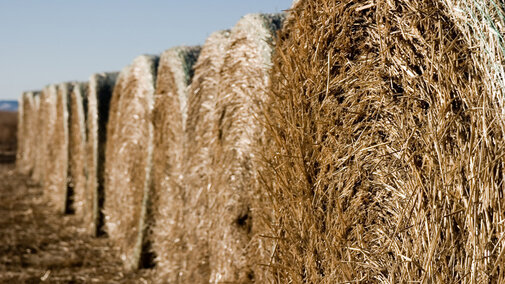Deciphering a Hay Test: Moisture
Having hay tested for nutrient quality is critical in getting the most out of the feedstuffs you have. Once the results come back, the next step is understanding the report you’ve received.
The first thing we notice on most feed or hay tests are the results in two different groups or columns. One is labeled along the lines of “as received” or “as fed”, and another “dry basis.” Understanding the difference in these two columns is key to properly using the information provided when feeding your livestock.
“As received” represents the analysis of the sample as it was provided. This is what we will use to figure out rations or how much hay animals need to be provided. “Dry basis” is the sample after all moisture has been removed and doesn’t accurately represent the sample as it sits in the yard.
So why bother with “dry basis” if we don’t use it to figure feed amounts? Because when it comes to comparing feeds and finding the correct ratios in a ration, we need to compare things on an equal playing field.
For example, we could have a forage test on hay and silage come back as equal on a dry basis for energy, meaning that both feeds would provide the same amount of energy if dried out and fed. For the hay, this is pretty close to reality, but the silage contains much more water as is. Because of this, we would have to feed quite a bit more silage than hay to reach the same amount of energy in the ration, simply due to the extra weight from water.
“As received” and “dry basis” columns may make a feed report look daunting, but understanding and using both is critical to getting the most out of your feed.
Alfalfa as a Supplemental Protein
By Brad Schick
Choosing the right protein may help bring the cost of feed down and more accurately meet the needs of our cattle. In some rations, alfalfa might be that choice.
Whether cattle are on winter range, cornstalks or being fed prairie/grass hay, they often will need extra protein in their diet. Protein sources vary in cost and effectiveness. Protein is important because it is used by the rumen microbes to help break down low quality forage and then used by animal itself as microbial protein as they pass through the digestive tract. It’s essentially used twice.
Many times, alfalfa is one of the cheapest natural sources of protein, easy to use, and doesn’t require additional equipment. Non-protein sources of nitrogen such as urea may be cheap but won’t be as effective with low quality forage. The first steps to finding out how much extra protein your cattle need include testing your feeds and forages for protein and estimating consumption rate. Then determine the amount of supplementation needed, which will depend on if you are dealing with weaned growing calves, dry pregnant cows, or lactating cows and nursing calves.
Some winter diets such as winter range, cornstalks or grass hay may require approximately one pound of extra protein per day. This can be supplemented every day or every other day and still keep cows productive, healthy and meet requirements.

